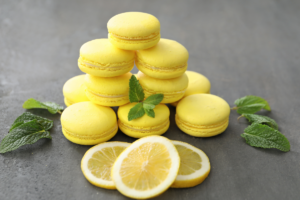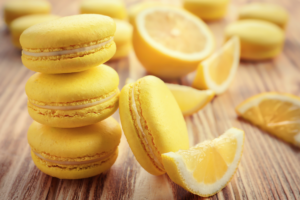Introduction to Lemon Macarons: A Culinary Delight
The Allure of Lemon Macarons
Lemon macarons, a delightful fusion of French patisserie artistry and the vibrant zest of lemons, have charmed dessert lovers globally. Their appeal lies not just in their dainty appearance but also in the exquisite harmony of flavors they offer. Amidst a plethora of sweet options, lemon macarons stand out with their unique blend of tangy and sweet notes.
Diverse Recipes and Creative Variations
At their heart, lemon macarons are a blend of fundamental ingredients: almond flour, egg whites, sugar, and the essential burst of lemon. This basic mix, however, opens up a universe of creative possibilities. From the traditional lemon curd filling to inventive variations like lemon-thyme buttercream, the range of recipes available makes lemon macarons a dynamic choice for any baker seeking to infuse their creations with a citrusy flair.
Crafting the Perfect Lemon Macarons
Selecting the Right Ingredients
The art of making Lemon Macarons is akin to a painter choosing their colors – precision is crucial. The base is almond flour, where selecting a fine, blanched variety ensures a smooth, perfect shell. The lemon element, whether zest, extract, or a combination, is vital for that bright, citrusy essence. The combination of aged egg whites and a mix of granulated and powdered sugar forms the structure and sweetness of these delicate treats.
The Finest Almond Flour
Choosing the right almond flour is critical. A fine grind is essential for achieving those smooth, desirable tops, avoiding the pitfalls of a coarse texture.
Emphasizing Quality Lemon Flavor
The lemon flavor in your macarons should be bold and distinct. Opting for high-quality lemon zest or extract is key to imparting that vibrant, essential flavor, distinguishing your macarons from the rest.
Egg and Sugar Selection
Eggs, particularly the whites, are crucial in macaron making. Aged egg whites whip up more effectively, creating the perfect meringue. A combination of granulated sugar for stability and powdered sugar for sweetness is ideal.
The Macaron-Making Process
Embarking on the journey of making macarons can be challenging but rewarding with the right approach.
Mastering the Meringue
The meringue is the heart of the macaron. Whisk the aged egg whites to soft peaks, then add sugar until glossy and firm, being careful not to overbeat or underbeat.
Perfecting Macaronage
Macaronage, the folding of almond flour into the meringue, is a delicate process. Achieving the right consistency is key to avoiding lumpy or overly flat macarons.
Piping and Baking Techniques
Piping macarons requires precision and practice. Even circles and a gentle tap to release air bubbles are crucial. Baking should be done gently to achieve the perfect texture and appearance.
In the following section, we’ll dive into the fillings and flavors that make lemon macarons a delightful treat.
Exploring Fillings and Flavors
Classic and Innovative Fillings
The filling is the heart of a Lemon Macaron. Classic lemon curd offers a burst of citrusy goodness, while lemon buttercream provides a lighter, creamy alternative. Both fillings complement the crisp shell, creating a harmonious taste experience.
Homemade Lemon Curd
Making your own lemon curd can elevate your macarons. It involves balancing the tartness of lemons with sweetness, resulting in a smooth, glossy filling.
Lemon Buttercream and Its Variations
Buttercream offers versatility. Starting with a butter and powdered sugar base, adding lemon zest and juice creates a tangy flavor. Experimenting with vanilla or lavender adds unique twists.
Flavor Pairings and Combinations
Lemon macarons are perfect for flavor experimentation. Pairing lemon with other citrus flavors or incorporating herbs and spices can transform these treats into gourmet creations.
Overcoming Baking Challenges
Addressing Common Issues
Making Lemon Macarons can be tricky. Cracked shells and hollow macarons are common issues, often due to mixing or baking techniques. Finding the right balance in preparation and baking is key.
Expert Tips for Perfection
Temperature and humidity greatly affect macaron quality. Baking in optimal conditions and using precise techniques can lead to perfect results. Proper storage and maturation also play a role in enhancing flavor and texture.
Print
Lemon Macarons
Description
Lemon macarons are exquisite French confections that blend the delicate crunch of almond meringue shells with a zesty, creamy lemon filling. Renowned for their smooth tops and ruffled “feet,” these macarons offer a delightful balance of sweet and tangy flavors, making them a sophisticated treat for any occasion. Their vibrant lemon essence, captured in both the shell and the filling, provides a refreshing burst of citrus that’s both invigorating and indulgent.
Ingredients
For the Macaron Shells:
- 1 cup (100g) almond flour, finely ground
- 1 3/4 cups (200g) powdered sugar
- 3 large egg whites, at room temperature
- 1/4 cup (50g) granulated sugar
- 1/2 teaspoon lemon zest
- Yellow gel food coloring (optional)
For the Lemon Curd Filling:
- 1/3 cup (80ml) fresh lemon juice (about 2 lemons)
- 2 large eggs
- 1 large egg yolk
- 1/2 cup (100g) granulated sugar
- 4 tablespoons (60g) unsalted butter, cut into pieces
- 1 tablespoon lemon zest
For the Lemon Buttercream (Alternative Filling):
- 1/2 cup (115g) unsalted butter, softened
- 1 1/2 cups (180g) powdered sugar
- 2 tablespoons fresh lemon juice
- 1 teaspoon lemon zest
- Pinch of salt
Instructions
Making the Macaron Shells:
- Sift Together Dry Ingredients: Sift the almond flour and powdered sugar together into a large bowl. Discard any large pieces.
- Whip the Egg Whites: In a separate bowl, beat the egg whites until foamy. Gradually add granulated sugar, continuing to beat until stiff peaks form. Add lemon zest and a few drops of yellow food coloring (if using), and mix until just combined.
- Macaronage Process: Gently fold the dry ingredients into the egg whites in thirds, being careful not to overmix. The mixture should be thick, yet flow off the spatula in ribbons.
- Pipe the Macarons: Line baking sheets with parchment paper. Transfer the batter to a piping bag fitted with a round tip. Pipe small rounds onto the prepared sheets. Tap the sheets firmly on the counter to release any air bubbles.
- Rest and Bake: Let the macarons sit at room temperature for 30-60 minutes, until they form a skin on top. Preheat your oven to 300°F (150°C). Bake for 17-20 minutes, or until they are set and don’t wobble when nudged. Cool completely before filling.
Preparing the Lemon Curd:
- Cook the Curd: Whisk together lemon juice, eggs, egg yolk, and sugar in a saucepan. Cook over medium heat, stirring constantly, until thickened. Remove from heat.
- Add Butter and Zest: Stir in the butter and lemon zest until smooth. Cover with plastic wrap, pressing it directly onto the surface to prevent a skin from forming. Chill in the refrigerator until cold.
Making the Lemon Buttercream:
- Cream the Butter: Beat the butter until smooth and creamy. Gradually add powdered sugar, lemon juice, lemon zest, and a pinch of salt. Beat until light and fluffy.
Assembling the Macarons:
- Fill the Macarons: Once the shells are cool, pair them by size. Pipe a small amount of lemon curd or buttercream onto the flat side of one shell, then sandwich with its pair.
- Rest and Serve: Let the filled macarons rest in the refrigerator for at least one hour before serving. This allows the flavors to meld together.
Notes
- Ingredient Quality: Use the finest almond flour you can find for a smooth, refined texture. For the lemon flavor, fresh organic lemons are ideal. Their zest and juice will give a more vibrant taste compared to bottled lemon juice or artificial flavors.
- Meringue Mastery: Achieving the perfect meringue is crucial. Make sure your egg whites are at room temperature before you start whipping them. Add sugar gradually to form a glossy and stiff meringue. Be careful not to overbeat, as this can make the macarons dry.
- Macaronage Technique: This step involves folding the almond flour and powdered sugar mixture into the meringue. It’s essential to get this just right – the batter should flow like lava and form a thick ribbon when lifted. Over-mixing can lead to flat macarons, while under-mixing can cause them to not rise properly.
- Resting Time: Once piped, let the macarons rest until they form a skin – this can take anywhere from 15 to 60 minutes depending on the humidity. You’ll know they’re ready when you can touch them gently without the batter sticking to your finger.
- Consistent Baking: Use an oven thermometer to ensure the temperature is accurate. Slight variations can affect the outcome significantly. Bake one tray at a time in the center of the oven to ensure even cooking.
- Filling Flavor: For the lemon filling, consider making a homemade lemon curd. It offers a richer, more authentic flavor than store-bought versions. If you’re using buttercream, adding a bit of lemon zest can intensify the flavor.
- Maturation: Once filled, macarons benefit from maturing in the fridge for at least 24 hours. This process allows the flavors to meld together and the texture to develop, resulting in a perfectly balanced macaron.
Lemon Blueberry Cupcakes – Perfect Summer Delight: This article can be linked when mentioning the combination of lemon with other flavors, highlighting the compatibility of lemon in various dessert recipes. Discover other lemon-infused delights like Lemon Blueberry Cupcakes.


